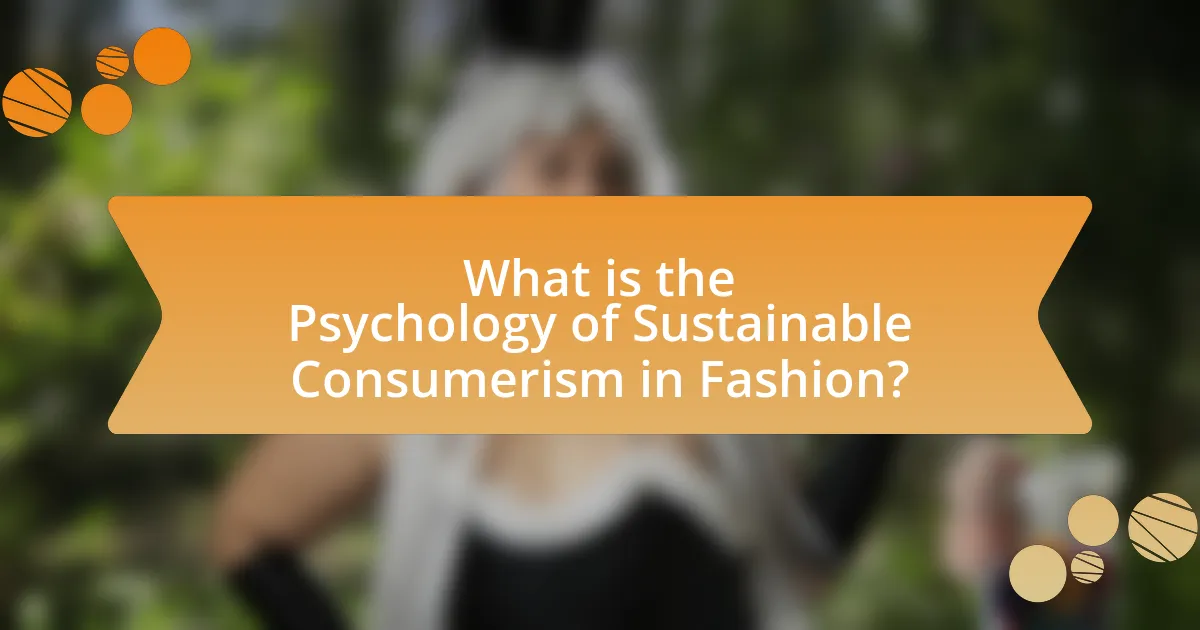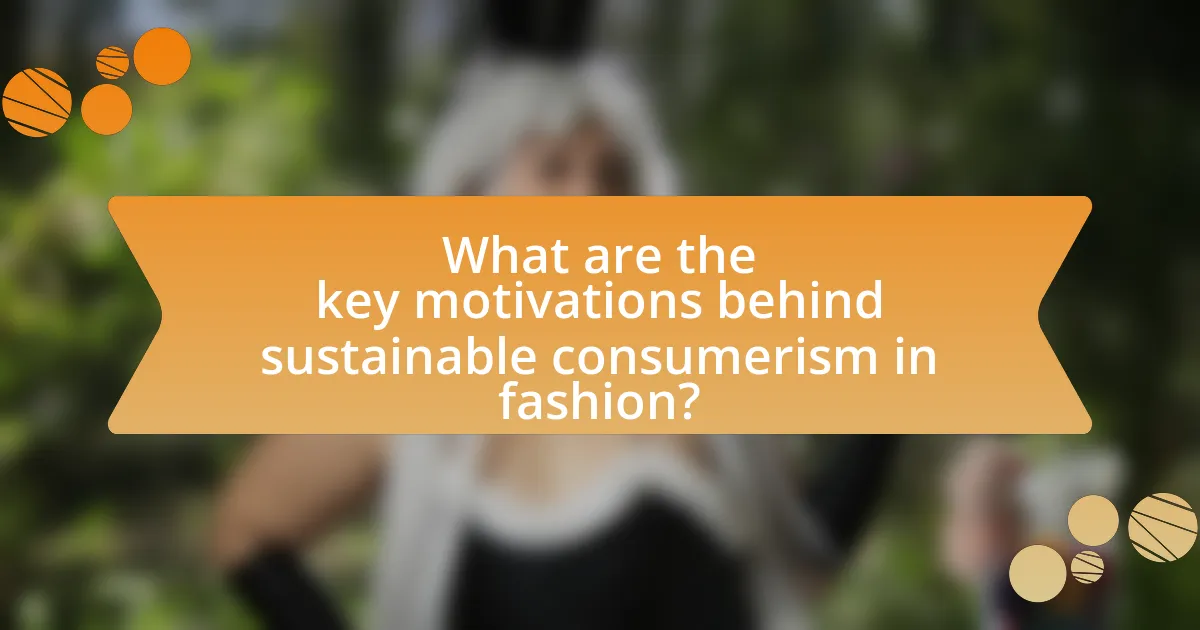The article explores the psychology of sustainable consumerism in the fashion industry, highlighting the mental and emotional factors that drive consumers to make environmentally and socially responsible clothing choices. It examines how consumer psychology influences purchasing behaviors, emphasizing the importance of values such as environmental consciousness, social identity, and ethical considerations. The article also discusses the emotional impact on purchasing decisions, the significance of sustainable consumerism in addressing environmental degradation, and the role of personal and cultural beliefs in shaping consumer behavior. Additionally, it addresses psychological barriers and misconceptions surrounding sustainable fashion, while offering insights into effective marketing strategies and best practices for brands to promote sustainable habits among consumers.

What is the Psychology of Sustainable Consumerism in Fashion?
The psychology of sustainable consumerism in fashion refers to the mental and emotional factors that drive consumers to prioritize environmentally and socially responsible clothing choices. This behavior is influenced by a growing awareness of environmental issues, ethical concerns regarding labor practices, and a desire for authenticity and personal identity. Research indicates that consumers who identify with sustainability values are more likely to engage in eco-friendly purchasing behaviors, as seen in a study by McKinsey & Company, which found that 67% of consumers consider sustainability when making fashion purchases. This trend reflects a shift in consumer mindset, where individuals seek to align their purchasing decisions with their values, leading to increased demand for sustainable fashion brands.
How does consumer psychology influence sustainable fashion choices?
Consumer psychology significantly influences sustainable fashion choices by shaping individuals’ attitudes and behaviors towards eco-friendly products. Factors such as social identity, perceived consumer effectiveness, and emotional responses drive consumers to prefer sustainable fashion brands. For instance, research indicates that consumers who identify strongly with environmental values are more likely to purchase sustainable clothing, as they perceive it as a reflection of their identity. Additionally, studies show that when consumers believe their purchasing decisions can positively impact the environment, they are more inclined to choose sustainable options. This psychological motivation is supported by data from a 2021 survey by McKinsey, which found that 67% of consumers consider sustainability when making fashion purchases, highlighting the direct correlation between consumer psychology and sustainable fashion choices.
What psychological factors drive consumers towards sustainable fashion?
Psychological factors driving consumers towards sustainable fashion include environmental consciousness, social identity, and ethical considerations. Environmental consciousness motivates consumers to choose sustainable options to reduce their ecological footprint, as studies show that 66% of global consumers are willing to pay more for sustainable brands. Social identity influences purchasing decisions, as individuals often align their fashion choices with their values and the desire to be perceived positively by peers. Ethical considerations, such as concern for labor practices and animal welfare, also play a significant role, with 73% of millennials indicating they would pay extra for sustainable products. These factors collectively shape consumer behavior towards sustainable fashion.
How do emotions impact purchasing decisions in sustainable fashion?
Emotions significantly influence purchasing decisions in sustainable fashion by driving consumer motivations and preferences. Positive emotions, such as joy and pride, can enhance the appeal of sustainable products, as consumers often feel a sense of fulfillment when making environmentally conscious choices. Research indicates that consumers are more likely to purchase sustainable fashion items when they associate them with positive emotional outcomes, such as contributing to social good or reducing environmental harm. For instance, a study published in the Journal of Consumer Research found that emotional appeals in marketing, such as highlighting the positive impact of sustainable practices, can lead to increased purchase intentions among consumers. This demonstrates that emotions play a crucial role in shaping consumer behavior in the sustainable fashion sector.
Why is sustainable consumerism important in the fashion industry?
Sustainable consumerism is important in the fashion industry because it addresses environmental degradation and promotes ethical practices. The fashion industry is one of the largest polluters globally, contributing to significant waste and carbon emissions; for instance, it is responsible for 10% of global carbon emissions and produces over 92 million tons of waste annually. By prioritizing sustainable consumerism, brands can reduce their ecological footprint and encourage responsible production and consumption patterns. This shift not only helps mitigate climate change but also fosters social responsibility, as it often involves fair labor practices and the use of eco-friendly materials.
What are the environmental impacts of fast fashion?
Fast fashion significantly contributes to environmental degradation through excessive resource consumption, pollution, and waste generation. The industry is responsible for approximately 10% of global carbon emissions, primarily due to the energy-intensive processes involved in manufacturing and transporting garments. Additionally, fast fashion leads to the depletion of water resources; for instance, producing a single cotton t-shirt requires about 2,700 liters of water, enough for one person to drink for two and a half years. Furthermore, the disposal of fast fashion items contributes to landfill overflow, with an estimated 92 million tons of textile waste generated annually, much of which is non-biodegradable. These facts illustrate the profound negative impact of fast fashion on the environment, highlighting the urgent need for sustainable practices in the fashion industry.
How does sustainable consumerism contribute to social change?
Sustainable consumerism contributes to social change by promoting ethical practices and environmental awareness among consumers, leading to shifts in market demand and corporate behavior. When consumers prioritize sustainable products, companies are incentivized to adopt eco-friendly practices, which can result in reduced waste, lower carbon emissions, and improved labor conditions. For instance, a report by Nielsen indicates that 66% of global consumers are willing to pay more for sustainable brands, demonstrating a clear market trend towards sustainability. This consumer behavior not only influences corporate strategies but also fosters a culture of responsibility and accountability, encouraging broader societal shifts towards sustainability and ethical consumption.

What are the key motivations behind sustainable consumerism in fashion?
The key motivations behind sustainable consumerism in fashion include environmental concern, ethical considerations, and social responsibility. Consumers increasingly prioritize eco-friendly materials and production methods due to rising awareness of climate change and its impact on the planet. A study by McKinsey & Company found that 67% of consumers consider sustainability when making a purchase, indicating a significant shift towards environmentally conscious buying behavior. Additionally, ethical considerations, such as fair labor practices and animal welfare, drive consumers to support brands that align with their values. Research from Nielsen shows that 73% of millennials are willing to pay more for sustainable products, reflecting a strong desire for social responsibility in their purchasing decisions.
How do values and beliefs shape consumer behavior in fashion?
Values and beliefs significantly shape consumer behavior in fashion by influencing purchasing decisions and brand loyalty. Consumers who prioritize sustainability, for instance, are more likely to support brands that demonstrate ethical practices, such as using eco-friendly materials or fair labor conditions. Research indicates that 66% of global consumers are willing to pay more for sustainable brands, reflecting a strong alignment between personal values and shopping habits. Additionally, beliefs about social responsibility can drive consumers to favor companies that engage in charitable initiatives, further impacting their buying choices. This connection between values, beliefs, and consumer behavior underscores the importance of aligning fashion brands with the ethical expectations of their target audience.
What role do personal values play in sustainable fashion choices?
Personal values significantly influence sustainable fashion choices by guiding consumers’ preferences and behaviors towards environmentally and socially responsible options. Individuals who prioritize values such as environmental stewardship, ethical labor practices, and social justice are more likely to support brands that align with these principles. Research indicates that consumers with strong personal values related to sustainability are willing to pay a premium for eco-friendly products, as evidenced by a study published in the Journal of Consumer Research, which found that 66% of consumers are willing to pay more for sustainable brands. This alignment between personal values and purchasing decisions underscores the critical role that individual beliefs play in shaping the sustainable fashion landscape.
How do cultural beliefs influence sustainable consumerism?
Cultural beliefs significantly influence sustainable consumerism by shaping individuals’ values, priorities, and behaviors regarding consumption. For instance, cultures that emphasize community and environmental stewardship often encourage consumers to prioritize sustainable products, as seen in many Indigenous cultures that practice sustainable resource management. Research indicates that consumers from collectivist societies are more likely to engage in sustainable practices, as they view their purchasing decisions as a reflection of their social responsibility. Additionally, cultural narratives around sustainability, such as those found in Scandinavian countries, promote eco-friendly consumption as a societal norm, leading to higher rates of sustainable purchasing behaviors.
What psychological barriers exist to sustainable consumerism in fashion?
Psychological barriers to sustainable consumerism in fashion include cognitive dissonance, social norms, and perceived inconvenience. Cognitive dissonance occurs when consumers struggle to reconcile their desire for sustainability with the allure of fast fashion, leading to guilt and avoidance of sustainable choices. Social norms heavily influence consumer behavior, as individuals often prioritize fitting in with peers over making environmentally friendly purchases. Additionally, perceived inconvenience, such as the belief that sustainable options are less accessible or more time-consuming to obtain, deters consumers from adopting sustainable practices. These barriers collectively hinder the transition to sustainable consumerism in the fashion industry.
What misconceptions do consumers have about sustainable fashion?
Consumers often believe that sustainable fashion is significantly more expensive than conventional fashion, which is a misconception. While some sustainable brands do have higher price points due to ethical sourcing and production practices, many affordable options exist that prioritize sustainability without a substantial cost increase. For instance, brands like Everlane and H&M’s Conscious Collection offer sustainable choices at competitive prices, demonstrating that eco-friendly fashion can be accessible to a wider audience. Additionally, consumers may think that sustainable fashion lacks variety and style; however, numerous designers are now creating fashionable, trendy pieces that adhere to sustainable practices, proving that style and sustainability can coexist.
How does perceived cost affect sustainable fashion purchases?
Perceived cost significantly influences sustainable fashion purchases by affecting consumers’ willingness to buy eco-friendly products. When consumers perceive sustainable fashion items as too expensive compared to conventional options, they are less likely to make a purchase. Research indicates that 66% of consumers consider price a major barrier to buying sustainable products, as highlighted in a study by the Global Fashion Agenda and McKinsey & Company. This perception of high cost can deter consumers from prioritizing sustainability, even if they value ethical practices. Thus, addressing perceived cost through pricing strategies can enhance the appeal of sustainable fashion.

How can brands effectively promote sustainable consumerism in fashion?
Brands can effectively promote sustainable consumerism in fashion by implementing transparent supply chains and engaging in educational marketing. Transparency allows consumers to understand the environmental and social impacts of their purchases, fostering trust and encouraging responsible buying behavior. For instance, brands like Patagonia provide detailed information about their sourcing and production processes, which has been shown to increase consumer loyalty and willingness to pay a premium for sustainable products. Additionally, educational marketing campaigns that highlight the benefits of sustainable fashion, such as reduced waste and ethical labor practices, can shift consumer perceptions and behaviors. Research indicates that consumers are more likely to support brands that align with their values, particularly regarding sustainability, as evidenced by a 2021 survey where 66% of respondents stated they would pay more for sustainable brands.
What marketing strategies resonate with consumers interested in sustainability?
Marketing strategies that resonate with consumers interested in sustainability include transparency, storytelling, and community engagement. Transparency involves openly sharing information about sourcing, production processes, and environmental impact, which builds trust and credibility. For instance, brands like Patagonia provide detailed insights into their supply chain and environmental initiatives, appealing to eco-conscious consumers. Storytelling connects consumers emotionally to the brand’s mission and values, as seen in campaigns that highlight the positive impact of sustainable practices. Community engagement fosters a sense of belonging and shared values, exemplified by brands that involve customers in sustainability initiatives or local environmental projects. These strategies effectively align with the values of sustainability-focused consumers, driving brand loyalty and purchase decisions.
How can storytelling enhance the appeal of sustainable fashion brands?
Storytelling enhances the appeal of sustainable fashion brands by creating emotional connections with consumers, which fosters loyalty and engagement. When brands share narratives about their ethical practices, environmental impact, and the artisans behind their products, they humanize their offerings and resonate with consumers’ values. Research indicates that 55% of consumers are more likely to purchase from brands that tell compelling stories about their sustainability efforts, as these narratives provide context and meaning to their purchases. By effectively communicating their mission and the positive impact of their products, sustainable fashion brands can differentiate themselves in a crowded market and attract conscious consumers.
What role does transparency play in consumer trust for sustainable brands?
Transparency is crucial in building consumer trust for sustainable brands. When brands openly share information about their sourcing, production processes, and environmental impact, consumers are more likely to perceive them as credible and trustworthy. Research indicates that 94% of consumers are more likely to be loyal to a brand that offers complete transparency, as it fosters a sense of accountability and ethical responsibility. Furthermore, transparency allows consumers to make informed choices, aligning their purchases with their values, which is particularly important in the context of sustainable fashion. This alignment enhances brand loyalty and encourages repeat purchases, ultimately contributing to the brand’s long-term success.
What are the best practices for encouraging sustainable consumer behavior?
The best practices for encouraging sustainable consumer behavior include promoting awareness, providing incentives, and facilitating access to sustainable options. Promoting awareness involves educating consumers about the environmental impact of their choices, which can be achieved through campaigns and informative labeling. Research indicates that consumers are more likely to engage in sustainable practices when they understand the consequences of their actions (Thøgersen, 2014). Providing incentives, such as discounts for returning used products or loyalty programs for sustainable purchases, can motivate consumers to choose eco-friendly options. Additionally, facilitating access by ensuring that sustainable products are readily available and affordable can significantly influence consumer behavior. A study by the Ellen MacArthur Foundation highlights that when sustainable products are easily accessible, consumer adoption rates increase (Ellen MacArthur Foundation, 2017).
How can education influence consumer choices in sustainable fashion?
Education significantly influences consumer choices in sustainable fashion by increasing awareness and understanding of environmental impacts and ethical considerations. When consumers are educated about the negative effects of fast fashion, such as pollution and labor exploitation, they are more likely to make informed decisions that favor sustainable brands. Research indicates that consumers with higher levels of education are more likely to prioritize sustainability in their purchasing behavior, as they possess the knowledge to evaluate the sustainability claims of brands critically. For instance, a study published in the Journal of Consumer Research found that consumers who received information about the environmental benefits of sustainable fashion were more inclined to choose eco-friendly products over conventional options. This demonstrates that education not only shapes consumer attitudes but also drives behavioral change towards more sustainable fashion choices.
What initiatives can brands implement to foster sustainable habits among consumers?
Brands can implement educational campaigns to foster sustainable habits among consumers. These initiatives can include workshops, online courses, and informative content that highlight the environmental impact of fashion choices, encouraging consumers to make informed decisions. For instance, a study by the Ellen MacArthur Foundation found that educating consumers about the lifecycle of clothing can significantly influence their purchasing behavior, leading to more sustainable choices. Additionally, brands can adopt transparent supply chain practices, showcasing their sustainability efforts and the ethical sourcing of materials, which can build trust and motivate consumers to support sustainable brands.
What practical tips can consumers follow to embrace sustainable fashion?
Consumers can embrace sustainable fashion by prioritizing quality over quantity when purchasing clothing. This approach encourages the selection of durable, timeless pieces that reduce the frequency of replacements, ultimately minimizing waste. According to a study by the Ellen MacArthur Foundation, extending the life of clothing by just nine months can reduce carbon, water, and waste footprints by 20-30%. Additionally, consumers should consider shopping second-hand or vintage, as this practice not only supports circular fashion but also decreases demand for new production. Engaging in clothing swaps with friends or community events can further promote sustainability by extending the lifecycle of garments. Lastly, consumers can support brands that prioritize ethical practices and transparency, as research indicates that 66% of consumers are willing to pay more for sustainable brands.



